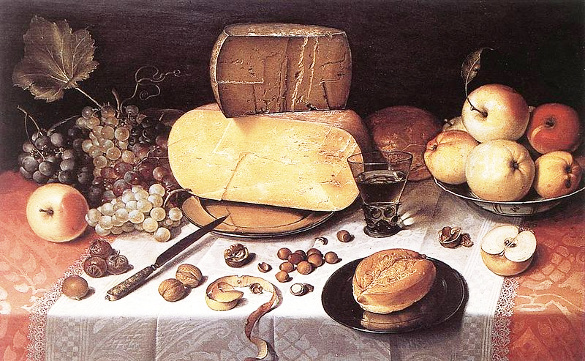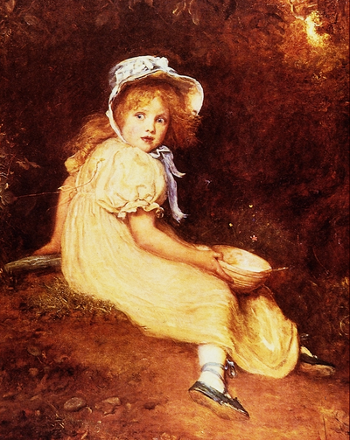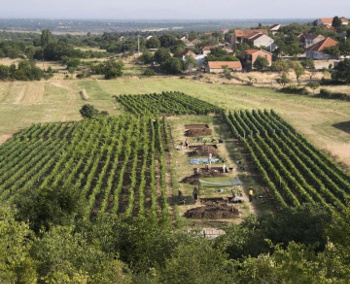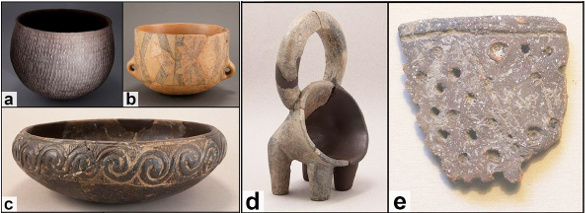Neolithic Cheese
October 15, 2018
Like many others, I enjoyed watching
Family Matters on
television during the last
decade of the
20th century. The most memorable
character from that
television series was
Steve Urkel, played by the versatile
actor,
Jaleel White (b. November 27, 1976). Urkel was the
archetypal nerd, a serious
student and an
inventor. His
inventions were often strange, and they usually failed. He did invent a
time machine, a
plot device that's proven useful in many television shows, such as
Family Guy.
One thing that I remember about Urkel that's missing from his
Wikipedia page is his love of
cheese. There are so many types of cheese that everyone should find a favorite. I've always enjoyed
sharp cheddar, and I'm happy that there are
pills to prevent
cholesterol side-effects from eating too much cheese. Although there are supposed problems with the
nutritional value of
milk, the starting ingredient for making cheese, milk was once marketed as
Nature's perfect food. Here's the typical composition of
cow's milk:[1]
• Water: 87.3%
• Milk fat: 3.9%
• Proteins: 3.25% (Casein, 2.6%)
• Carbohydrates: 4.6% (Lactose)
• Minerals: 0.65% (Chlorides, phosphates, citrates, and carbonates of potassium, calcium, and magnesium)
• Organic acids: 0.18% (Citric, lactic, formic, acetic, and oxalic)
• Enzymes: Trace (Peroxidase, catalase, phosphatase, and lipase)
• Vitamins: Trace (Vitamin-A, Vitamin-C, Vitamin-D, B1/thiamine, and B2/riboflavin)

Cheese takes a central role in this "Still-Life with Fruit, Nuts and Cheese," a 1613 oil on panel painting by Floris van Dyck (c.1575-1651). (Current location, the Frans Hals Museum. Via Wikimedia Commons.)
Some cheese is very easy to make.
Farmer cheese is simply made by adding
rennet and
bacterial starter to
coagulate milk. The solid part of the coagulate, the
curd, are separated from the liquid
whey, and the curds are pressed to remove most of the
moisture to make a dry and crumbly cheese. My
wife uses a similar method to make
mozzarella using warmed milk, and there are many
recipes for this process online. As we all know,
Little Miss Muffet was very fond of
curds and whey, also known as
cottage cheese, which is also easy to make at home.

Little Miss Muffet
Sat on a tuffet,
Eating her curds and whey;
Along came a spider
Who sat down beside her
And frightened Miss Muffet away.
(A painting by John Everett Millais (1829–1896), via Wikimedia Commons.)
Not every sparkling
white wine can be called
Champagne in the
European Union, but only those from
a certain region in France about 100 miles east of
Paris. This is because of a
law known as
Appellation d'origine contrôlée. Likewise, certain cheeses have this type of
trademark status derived from another law, the
protected designation of origin (PDO). This is better known by its
Italian designation,
Denominazione di origine controllata. This law protects the
quality of the cheese by stating rules for its production.
The most important
PDO designation for cheese is for
Feta, a brined cheese that's decidedly easy to imitate. Some Italian cheeses with
PDO protection are
Gorgonzola,
Mozzarella di Bufala Campana,
Parmigiano Reggiano, and
Pecorino Romano. These cheeses are more
expensive than their
generic versions, and there are some people who actually prefer the generic versions over the originals. There are some entertaining
YouTube videos that explain cheese quality factors and
prices.[2-3]
Since it's possible to keep cheese from
spoiling for much longer than the milk from which it is made,
cheesemaking has been an important part of
human culture for a very long time. There is evidence for cheesemaking in the
Bronze Age, about 5,000 years ago. A recent study,
published as an
open access paper in
PLOS, has given evidence for cheesemaking in the
Neolithic, about 7,000 years ago.[4-5] The
authors are from
Pennsylvania State University (University Park, Pennsylvania),
Heriot-Watt University (Edinburgh, United Kingdom), the
Muzej grada Ŝibenika (Ŝibenik, Croatia), and the
Rochester Institute of Technology (Rochester, New York).[4]
Cheese was important to human expansion across
Europe, and cheese has health benefits that decrease
infant mortality. While
genetic studies have shown that many early humans were
lactose intolerant, this is less of a problem among
young children, who could consume this relatively
pathogen-free and
nutritious food and enhance their survival to
adulthood.[4]
Yogurt and cheese have decreased
lactose content, and this food source would have enabled expansion of populations to
northern latitudes where
cattle-rearing for milk production would supplement
agriculture.[4-5]

The archaeological site of Pokrovnik, one of two sites that revealed cheese production 7,000 years ago.
(Photo by Andrew M.T. Moore.)
Evidence for this production of cheese in the Neolithic comes from the detection of
fatty acids on
potsherds from two Neolithic
villages on the
Dalmatian coast,
east of the
Adriatic Sea.[5] These villages, Pokrovnik and Danilo Bitinj, were occupied between 6000 and 4800
BCE, and
analysis of potsherds showed evidence for
meat,
fish, and milk.[5] Interestingly, specific
pottery types were used for different foods, cheese
residue being most common on
rhyta and
sieves.[5]
Radiocarbon dating was by analysis of stable
carbon isotopes of the lipid residue.[4] This
research was
funded by the
National Science Foundation and the
National Geographic Society, among other sources.[5]

Examples of pottery types from the Dalmatian Neolithic. (From a photo by McClure et al., 2018.)
References:
- Composition of Milk, Cornell University Dairy Extension (PDF File).
- Cheese Expert Guesses More Cheap vs Expensive Cheeses, Epicurious YouTube Video, November 20, 2017.
- Cheese Expert Guesses More Cheap vs Expensive Cheeses, Epicurious YouTube Video, July 24, 2018.
- Sarah B. McClure, Clayton Magill, Emil Podrug, Andrew M. T. Moore, Thomas K. Harper, Brendan J. Culleton, Douglas J. Kennett, and Katherine H. Freeman, "Fatty acid specific δ13C values reveal earliest Mediterranean cheese production 7,200 years ago," PLoS ONE, vol. 13, no. 9 (September 5, 2018), Article no. e0202807, https://doi.org/10.1371/journal.pone.0202807. This is an open access paper with a PDF file here.
- Earliest Mediterranean cheese production revealed by pottery over 7,000 years old, PLOS Press Release, September 5, 2018.
Linked Keywords: Family Matters; television; decade; 20th century; character (arts); television series; Steve Urkel; actor; Jaleel White (b. November 27, 1976); archetypal; nerd; student; invention; inventor; time travel in fiction; time machine; plot device; Family Guy; Wikipedia; cheese; sharp cheddar; pharmaceutical drug; pill; lipid hypothesis; cholesterol side-effects; nutrition; nutritional; milk; cattle; cow; water; butterfat; milk fat; protein; casein; carbohydrate; lactose; mineral; chloride; phosphate; citric acid; citrate; carbonate; potassium; calcium; magnesium; organic acid; lactic acid; formic acid; acetic acid; oxalic acid; enzyme; peroxidase; catalase; phosphatase; lipase; vitamin; vitamin-A; vitamin-C; vitamin-D; B1/thiamine; B2/riboflavin; oil painting; Floris van Dyck (c.1575-1651); Frans Hals Museum; Still-Life with Fruit, Nuts and Cheese; farmer cheese; rennet; fermentation starter; bacterial starter; coagulation; coagulate; curd; whey; moisture; wife; mozzarella; recipe; Little Miss Muffet; cottage cheese; John Everett Millais (1829–1896); white wine; Champagne; European Union; Champagne (wine region); France; Paris; law<; Appellation d'origine contrôlée; trademark; protected designation of origin (PDO); Italy; Italian; Denominazione di origine controllata; quality; feta; gorgonzola; mozzarella di bufala Campana; parmigiano Reggiano; pecorino Romano; expensive; generic version; YouTube video; price; food spoilage; spoil; cheesemaking; human culture; Bronze Age; scientific literature; publish; open access journal; open access paper; PLOS; Neolithic; author; Pennsylvania State University (University Park, Pennsylvania); Heriot-Watt University (Edinburgh, United Kingdom); Muzej grada Ŝibenika (Ŝibenik, Croatia); Rochester Institute of Technology (Rochester, New York); Europe; infant mortality; gene; genetic; lactose intolerance; lactose intolerant; child; young children; pathogenic bacteria; pathogen; nutrition; nutritious; food; adulthood; yogurt; northern hemisphere; northern latitude; animal husbandry; cattle-rearing; agriculture; archaeology; archaeological; Pokrovnik; Andrew M.T. Moore; fatty acid; potsherd; village; Dalmatian coast; east; Adriatic Sea; Common Era; BCE; analytical chemistry; chemical analysis; meat; fish; pottery; residue (chemistry); rhyton; rhyta; sieve; radiocarbon dating; carbon isotope; research; funding of science; National Science Foundation; National Geographic Society.